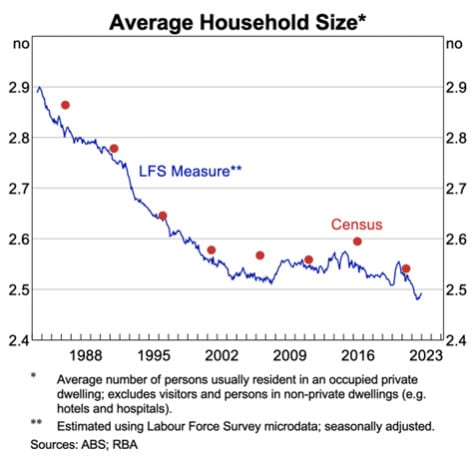- The first step is making the call.
- 1300 022 482
- hello@searchpartyproperty.com.au
What Can Household Size Tell Us About The Property Market?

The Australian housing market is an incredibly complex entity, shaped by an interplay of various factors that create distinct trends and patterns. One factor that often goes unnoticed, but plays a vital role in understanding the housing market, is the average household size.
Over the past few decades, the average number of people living in each Australian household has steadily declined from 2.9 in the mid-1980s, driven by factors such as an aging population, falling fertility and marriage rates, and higher household incomes.
Since the early 2000s, household size has held relatively steady at 2.5-2.6 people per household. There have even been a few significant spikes in the figures – particularly in the lead up to and during the 2008 financial crisis.
More recently however, the COVID-19 pandemic appears to have catalysed a return to the historic downwards trend, as the average household dipped to historical lows of a little under 2.5 people per household. This was particularly noticeable in Sydney and Melbourne, where health restrictions, lockdowns, and changes in migration flows from overseas no doubt played a significant role.

The COVID-19 fall in household size, as estimated by the RBA, led to an increase of 120,000 extra households during 2021. Remarkably, this impact nearly offset the number of households in Australia that were ‘absent’ due to near-zero net migration. The rise in overall number of households increased housing demand by as much as what typical immigration levels otherwise would.
Following 2021 there has since been a slight increase in household size, but for the first time in Australia’s history, the traditional nuclear family is no longer the dominant pattern among households. Census data indicates a major decline in the share of households consisting of three individuals or more. Couples, however, have maintained a consistent proportion. In contrast, the prevalence of single-person households has notably risen, ascending from 24.42 percent in 2016 to 25.56 percent in 2021. Simultaneously, the proportion of homes with four or more bedrooms has surged by over two percentage points, reaching 34.8 percent. This surge has outpaced a modest increase in the prevalence of single-bedroom homes. Now more than ever, more households are being formed, causing greater intrinsic demand for housing (given current levels of population growth).
In the decade to 2022, Australia recorded between 150,000 and 200,000 new dwellings per year being added to the national housing stock, taking the total number of dwellings from 9 million in 2012 to 10.9 million by December 2022. This growth was stronger than population growth alone in all years since 2014. A high proportion of working-age adults arriving as permanent migrants and long-term residents immediately adds to housing demand, yet the ‘stealthier’ added effects of decreasing household sizes only amplifies the upwards pressure exerted on prices by population growth.
Regional variations further add to the complexity of the housing market. Capital cities tend to have larger households than regional Australia, reflecting higher housing costs and proximity to employment and education opportunities. The up-down cycle in average household size since the onset of the pandemic has been largely driven by developments in capital cities, particularly Sydney and Melbourne.
Despite the challenges and complexities, the Australian housing market’s outlook remains positive for investors. The sustained demand driven by strong population growth and changing household dynamics means that property markets are likely to remain tight. These underlying, long-term drivers of demand, such as declining household sizes, add to the resilience of price growth into the future.
Bottom line – understanding household size is more than just statistical frivolity; it’s a crucial metric in grasping the market’s complexities and trajectory. With these demographic trends, real estate continues to present promising opportunities to shrewd investors.
Want to discuss this further?
For expert guidance in the implications of household size, and what it could mean for you as a property investor, book in for a free consultation to make informed decisions, tailored to your investment goals. Don’t let affordability challenges hinder your success. Act now with Search Party Property!




